For this edition of Classic Steel, we are going to take a look back at the incredible true story of Yamaha’s ill-fated Tri-Moto racing program.
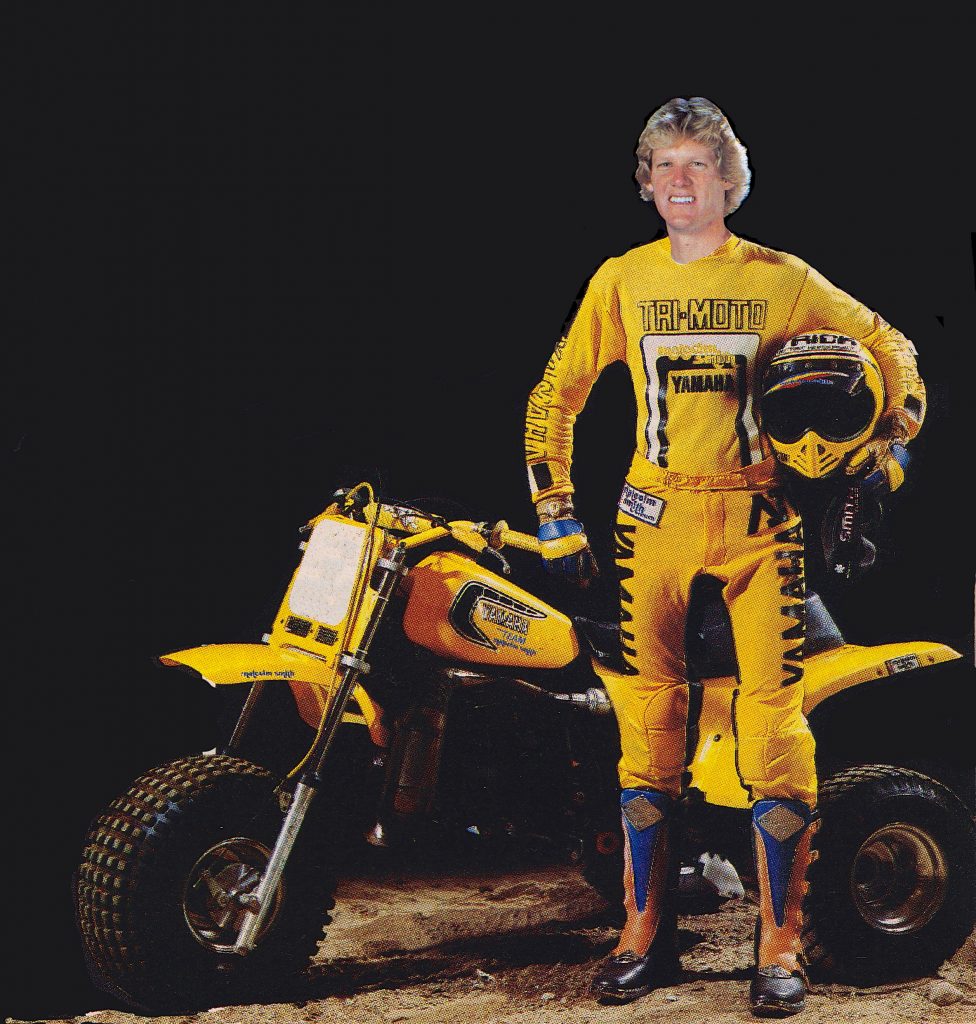 In 1982, Yamaha made big news by announcing that they would finally be making a run at Honda’s omnipotent Factory ATC racing program. The new “Tri-Moto” team would be headed by Bob Oliver and be a no-holds-barred full Factory effort. Perhaps most the most surprising news of all would be the man tapped to race the new machine- Yamaha ace, Broc Glover (Here posing next to the Factory Yamaha POS-83)
In 1982, Yamaha made big news by announcing that they would finally be making a run at Honda’s omnipotent Factory ATC racing program. The new “Tri-Moto” team would be headed by Bob Oliver and be a no-holds-barred full Factory effort. Perhaps most the most surprising news of all would be the man tapped to race the new machine- Yamaha ace, Broc Glover (Here posing next to the Factory Yamaha POS-83)
In the late sixties, motocross racing was purely the domain of the two-wheeler. In tracks across Europe, light and nimble CZ’s and Husky’s did battle against big booming BSA’s for motocross supremacy. Then. in 1969, the face of off-road riding was forever changed by the arrival of one machine – the Honda US90.
 In 1982, the announcement that The Golden Boy would be making the switch to ATVs for the ’83 season immediately sent shockwaves throughout the industry. Broc’s involvement was a huge win for the Tri-Moto team, lending the program immediate credibility.
In 1982, the announcement that The Golden Boy would be making the switch to ATVs for the ’83 season immediately sent shockwaves throughout the industry. Broc’s involvement was a huge win for the Tri-Moto team, lending the program immediate credibility.
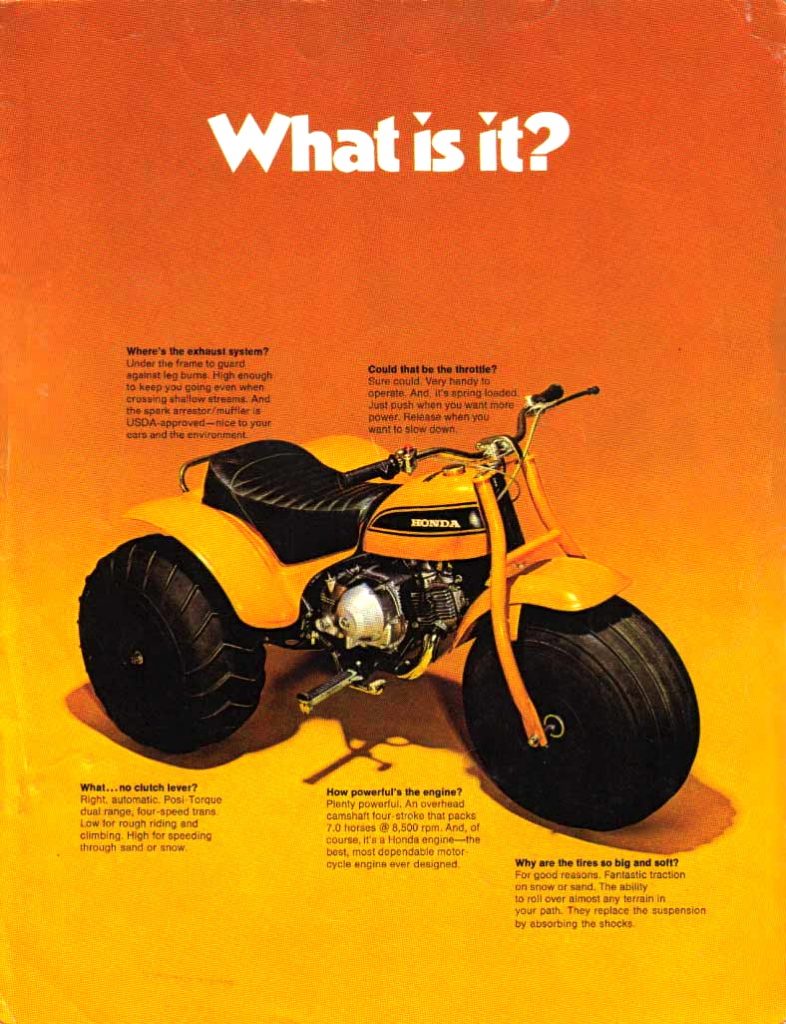 In 1969, Honda introduced the machine that would forever change the face of off-road riding in America – the US90 (later renamed ATC90). The little three-wheeled oddity was a huge hit with consumers and created an all-new category of light and nimble all-terrain vehicles.
In 1969, Honda introduced the machine that would forever change the face of off-road riding in America – the US90 (later renamed ATC90). The little three-wheeled oddity was a huge hit with consumers and created an all-new category of light and nimble all-terrain vehicles.
The US90 was the pet project of Honda engineer Osamu Takeuchi and took the nimble handling of a two-wheeler and mated it to the versatility of the six-wheeled all-terrain vehicles that were all the rage in the late sixties. This new hybrid class of machine was coined an “All Terrain Cycle” (ATC) by Honda and offered for sale to anxiously waiting consumers who snapped them up in droves.
 After inventing the category in 1969, Honda enjoyed a stranglehold on the class for more than a decade. No other manufacturer was up to challenging Big Red and they dominated ATC racing throughout the seventies.
After inventing the category in 1969, Honda enjoyed a stranglehold on the class for more than a decade. No other manufacturer was up to challenging Big Red and they dominated ATC racing throughout the seventies.
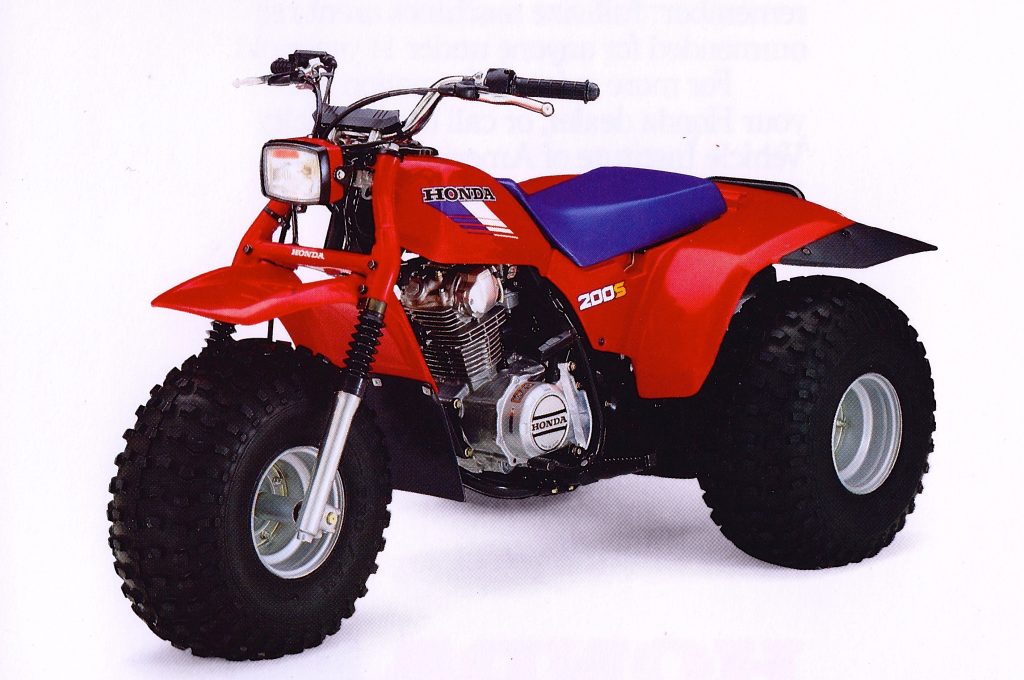 In 1981, Honda dropped a bombshell on the ATV industry with their first ATC200S (The S stood for SERIOUS). This was the first true factory built race-ready ATV (REAL SUSPENSION!) and a quantum leap beyond anything else available at the time. For Yamaha, this would be the catalyst for the Factory Tri-Moto racing program.
In 1981, Honda dropped a bombshell on the ATV industry with their first ATC200S (The S stood for SERIOUS). This was the first true factory built race-ready ATV (REAL SUSPENSION!) and a quantum leap beyond anything else available at the time. For Yamaha, this would be the catalyst for the Factory Tri-Moto racing program.
For Honda, the US90 (The name would be changed to ATC90 in 1971) would be an incredible hit from the very start. The addition of a third wheel for stability and the employment of specially made “high flotation” tires gave the all-new ATC an incredible advantage in the sloppy and slippery conditions that made life difficult on a traditional motorcycle. It was easy to get on and ride for complete beginners and appealed to riders who were intimidated by two-wheeled machines. Throughout the seventies, the demand for Honda’s new invention continued to grow and by the end of the decade, was dwarfing the production of their off-road two-wheeled machines.
 Once the Tri-Moto program was greenlit, Yamaha was fast to get some prototypes in the field for Glover to try. While early results were promising, the team knew they had a long way to go to catch Team Honda.
Once the Tri-Moto program was greenlit, Yamaha was fast to get some prototypes in the field for Glover to try. While early results were promising, the team knew they had a long way to go to catch Team Honda.
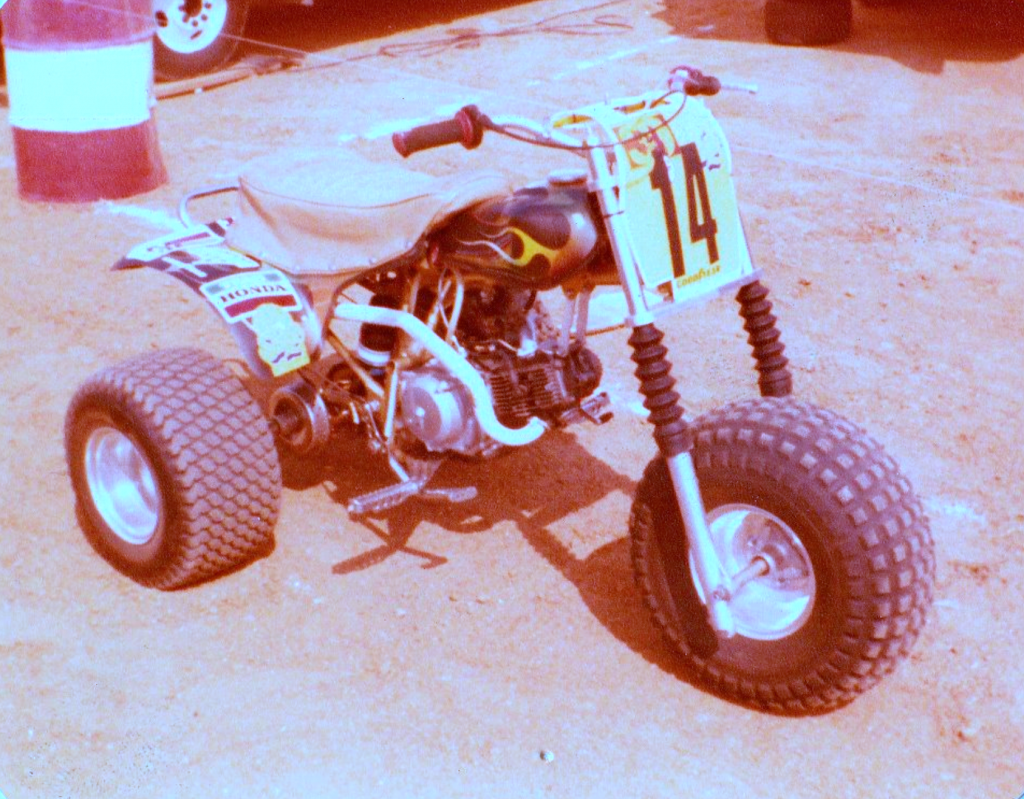 In 1981, going up against Team Honda was no laughing matter. Their bikes were the trickest in the pits (This #14 Works ATC200R of Mike Coe for instance, reportedly cost in excess of $100.000) and they had a nearly bottomless budget for R&D. When Yamaha undertook the Tri-Moto project, they were most definitely jumping into the deep end.
In 1981, going up against Team Honda was no laughing matter. Their bikes were the trickest in the pits (This #14 Works ATC200R of Mike Coe for instance, reportedly cost in excess of $100.000) and they had a nearly bottomless budget for R&D. When Yamaha undertook the Tri-Moto project, they were most definitely jumping into the deep end.
As the popularity of this new breed of machine exploded, people began expanding its usage into new areas. At first, the ATC was primarily a machine off-road fun, but it would quickly find its way into all manner of racing competition. Drag racing, TT, hill climb, cross-country, desert, and motocross were just a few of the disciplines that were invaded by the three-wheeled machines.
 Once testing was underway, it became apparent that the Tri-Moto was carrying too much weight over the front wheel. This was causing a dangerous huck-a-buck in the whoopties that was leading test riders to be ejected over the bars at an alarming rate. Here Yamaha testing ace Wally Whoop-De-Doo nails a perfect triple-auger-lawn-dart dismount on the POS prototype.
Once testing was underway, it became apparent that the Tri-Moto was carrying too much weight over the front wheel. This was causing a dangerous huck-a-buck in the whoopties that was leading test riders to be ejected over the bars at an alarming rate. Here Yamaha testing ace Wally Whoop-De-Doo nails a perfect triple-auger-lawn-dart dismount on the POS prototype.
 After four of the five Tri-Moto development riders were put in traction, it was decided a redesign of the chassis was necessary. Bob Oliver and his team actually considered turning the cylinder around backward but decided that was a dumb idea that would serve no real purpose, look stupid and screw with the handling. In the end, they settled on relocating the mill nine inches rearward and left the engine facing the correct direction.
After four of the five Tri-Moto development riders were put in traction, it was decided a redesign of the chassis was necessary. Bob Oliver and his team actually considered turning the cylinder around backward but decided that was a dumb idea that would serve no real purpose, look stupid and screw with the handling. In the end, they settled on relocating the mill nine inches rearward and left the engine facing the correct direction.
As the eighties began, ATC racing was quickly becoming the hottest growth area in off-road competition. Three wheelers were literally everywhere, and all manner of magazines and aftermarket accessory companies were quick to jump on the all-terrain bandwagon. Amazingly, in spite of all this success, the ATC game was really only had one participant. A full decade after the ATC’s introduction, there was still really only one game in town- Honda.
 Once R&D had finalized the basic design for Broc’s works bike, he was brought in to put the new machine through its paces. By all accounts, The Golden Boy was VERY impressed with the new works machine (Codenamed POS-83) and convinced he could win on the machine. As with any true thoroughbred, the hardest part about riding the works Tri-Moto POS was keeping the front end on the ground.
Once R&D had finalized the basic design for Broc’s works bike, he was brought in to put the new machine through its paces. By all accounts, The Golden Boy was VERY impressed with the new works machine (Codenamed POS-83) and convinced he could win on the machine. As with any true thoroughbred, the hardest part about riding the works Tri-Moto POS was keeping the front end on the ground.
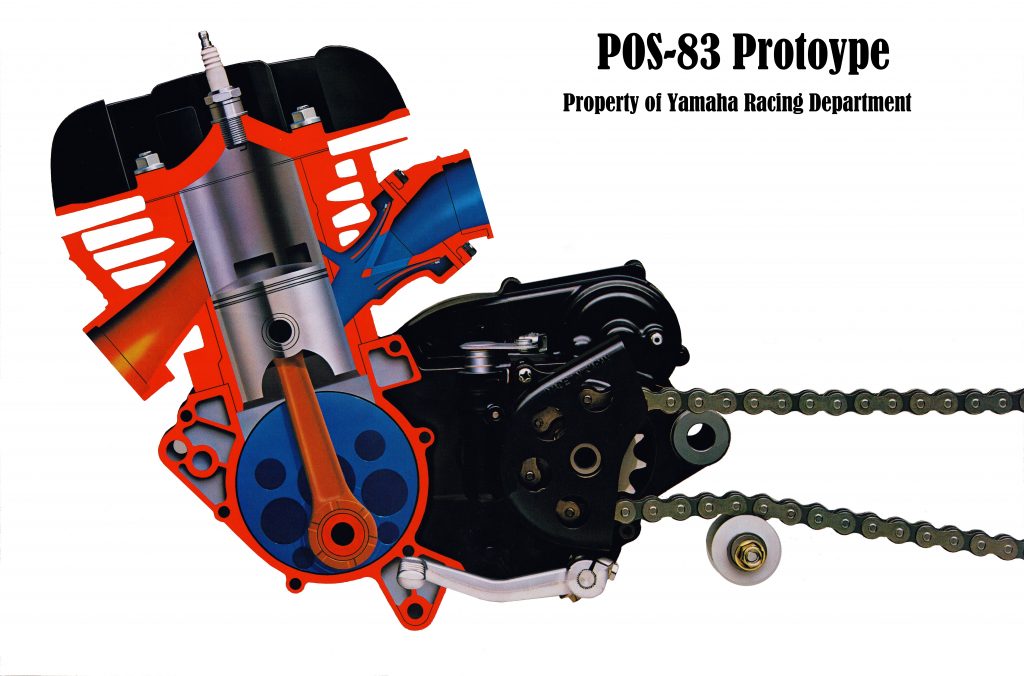 Exotica: The true heart of the POS-83 Tri-Moto was this exotic works mill. Displacing 249 cubic inches, the POS’s power plant featured dual powerbands, Boyesen reeds, a prototype Roost Boost, a massive 56mm carburetor and giant brass balls (in the YPVS governor). At the time of the Tri-Moto’s development, this was the most advanced motor in the Yamaha stable.
Exotica: The true heart of the POS-83 Tri-Moto was this exotic works mill. Displacing 249 cubic inches, the POS’s power plant featured dual powerbands, Boyesen reeds, a prototype Roost Boost, a massive 56mm carburetor and giant brass balls (in the YPVS governor). At the time of the Tri-Moto’s development, this was the most advanced motor in the Yamaha stable.
 Trendsetter: While most people credit Kawasaki with starting the platform peg craze in 1990, Broc’s works Tri- Moto had them in 1983.
Trendsetter: While most people credit Kawasaki with starting the platform peg craze in 1990, Broc’s works Tri- Moto had them in 1983.
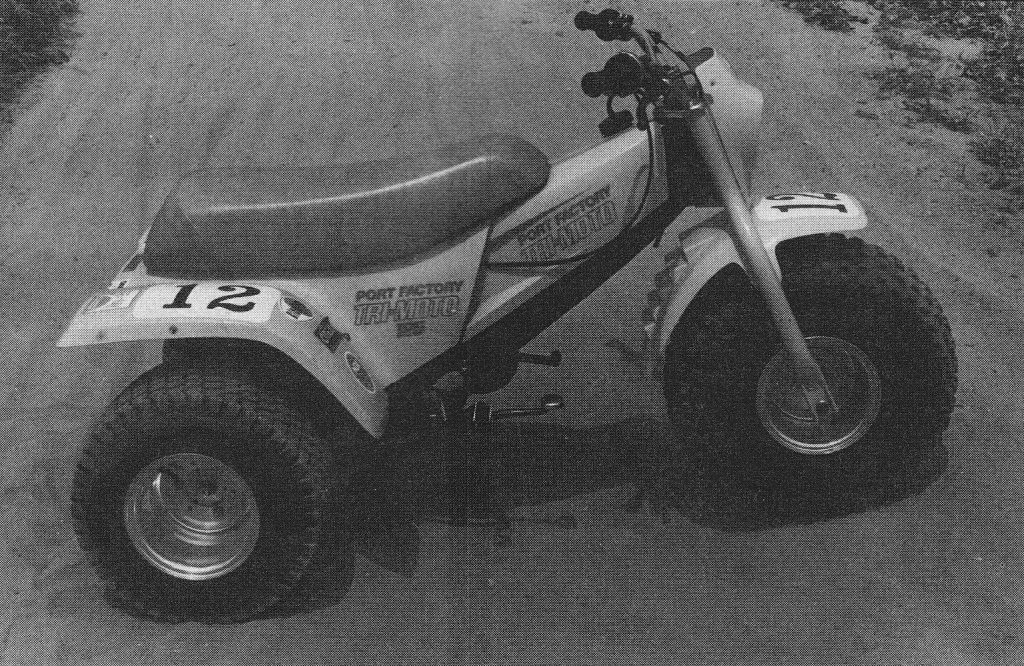 In addition to Glover, Yamaha support rider Donnie Cantaloupi was brought onboard to develop the new Tri-Moto. Donnie would enter the new machine in three shakedown races in the spring of ’82, to work out the bugs before the first National in April. At all three races, the fire-breathing POS-83 would pull massive holeshots, only to suffer catastrophic engine failures on the first lap.
In addition to Glover, Yamaha support rider Donnie Cantaloupi was brought onboard to develop the new Tri-Moto. Donnie would enter the new machine in three shakedown races in the spring of ’82, to work out the bugs before the first National in April. At all three races, the fire-breathing POS-83 would pull massive holeshots, only to suffer catastrophic engine failures on the first lap.

Super-stopper: Another trick feature on the POS-83 was its super-trick front braking system. In an era when most bikes were still using underpowered drum brakes, the Tri-Moto featured a dual-tandem braking system that employed a hydraulic disc on the right and a dual-leading shoe drum on the left.
 While most race bikes of the era used a whirlpool twist throttle, the POS used this trick thumb activated accelerator to fight arm pump. The red switch was used to engage the third gear powerband.
While most race bikes of the era used a whirlpool twist throttle, the POS used this trick thumb activated accelerator to fight arm pump. The red switch was used to engage the third gear powerband.
In 1981, the full might of Honda was brought to bear on the ATV motocross community with the introduction of the all-new ATC200S. The 200S was a no-holds-barred factory racer and borrowed liberally from Honda’s high-performance parts bin. A high-output two-stroke CR-derived power plant, long travel-suspension and racy styling made the 200S an ATV racer’s dream. With the new 200S in the stable and the power of Team Honda behind it, things were not looking good for fans of any color other than red in 1981.
 Special works tires were developed by Dunlop just for the Tri-Moto project. These spec tires used a 120% rubber composition layered over pure carbon titanium fiber weave to allow incredible grip in all conditions.
Special works tires were developed by Dunlop just for the Tri-Moto project. These spec tires used a 120% rubber composition layered over pure carbon titanium fiber weave to allow incredible grip in all conditions.
Although Yamaha had steadfastly ignored the ATC movement throughout the seventies, they had remained a two-wheeled motocross powerhouse. Yellow (and white, internationally) YZs won championship after championship, both in America and abroad with riders like Bob Hannah, Broc Glover and Heikki Mikkola at the controls. Then, as the eighties began, things began to go awry for the piano company. Injuries to star riders, economic woes, sub-par production machines sidetracked the domination of the tuning fork people. Worst of all, they had a complete lack of presence in the hottest division in off-road racing – ATVs. With no three-wheeled racing program, Yamaha knew they were leaving thousands of potential sales on the table. Japan knew if they were going to turn around their fortunes, they would have to get serious about racing ATVs.
 One innovation of the new Tri-Moto was this trick “bottom-link” Monocross rear suspension system. This new design was lower and lighter than the top-heavy design seen on the YZ’s of the time. It would be a full three years before the YZ line would receive this innovative design.
One innovation of the new Tri-Moto was this trick “bottom-link” Monocross rear suspension system. This new design was lower and lighter than the top-heavy design seen on the YZ’s of the time. It would be a full three years before the YZ line would receive this innovative design.
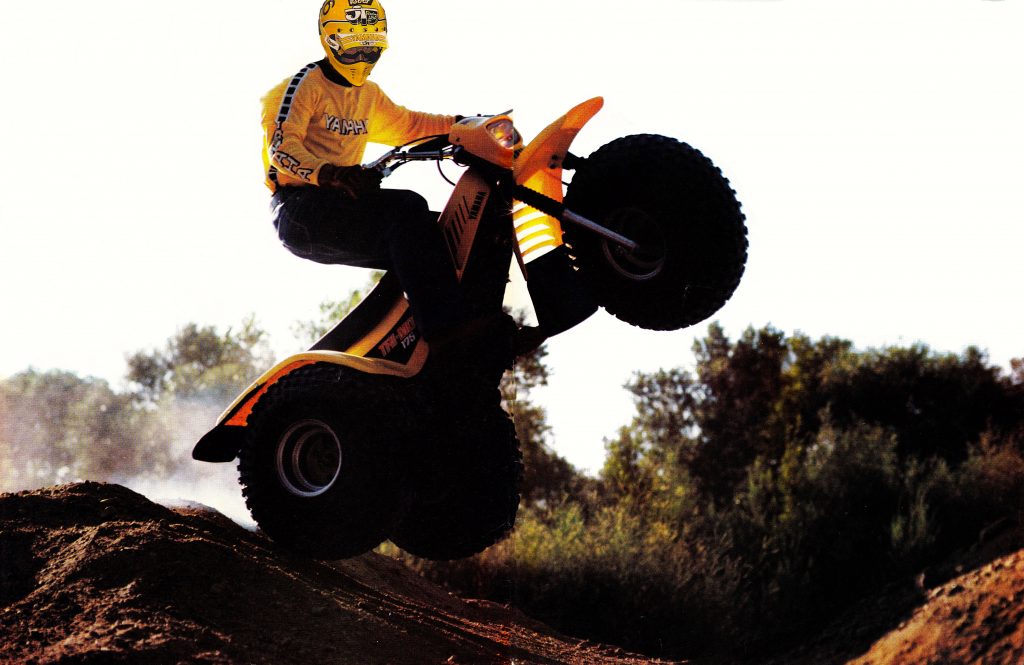 Rippa: With its nearly endless power reserve, bump-gobbling suspension and rearward weight bias, the POS-83 was a whoop eating monster. When asked about the new machine at the time, Broc Glover commented – “All I have to do is pin the throttle and this POS does the rest.”
Rippa: With its nearly endless power reserve, bump-gobbling suspension and rearward weight bias, the POS-83 was a whoop eating monster. When asked about the new machine at the time, Broc Glover commented – “All I have to do is pin the throttle and this POS does the rest.”
Knowing something had to be done quickly, Yamaha Japan fast-tracked a program to get them in the ATV racing game before it was too late. The directive came straight from the head of racing in Japan at the time, Swizcoresan Sinjinmoser, and the message was clear – “beat Honda at all costs”. Immediately, Yamaha put their best engineers on the program, both here and in Japan. Domestically, Bob Oliver was made the head of the new “Tri-Moto” program and put in charge of developing a new works racing trike code-named “POS-83”. In order to compete with the omnipotent Team Honda, Oliver knew they would need their best guy on the program, so he petitioned American Yamaha to let him have Broc Glover. At the time, Glover was a multi-time Motocross champion and one of Yamaha’s biggest stars. It Oliver could get Broc onboard, the program would gain immediate credibility.
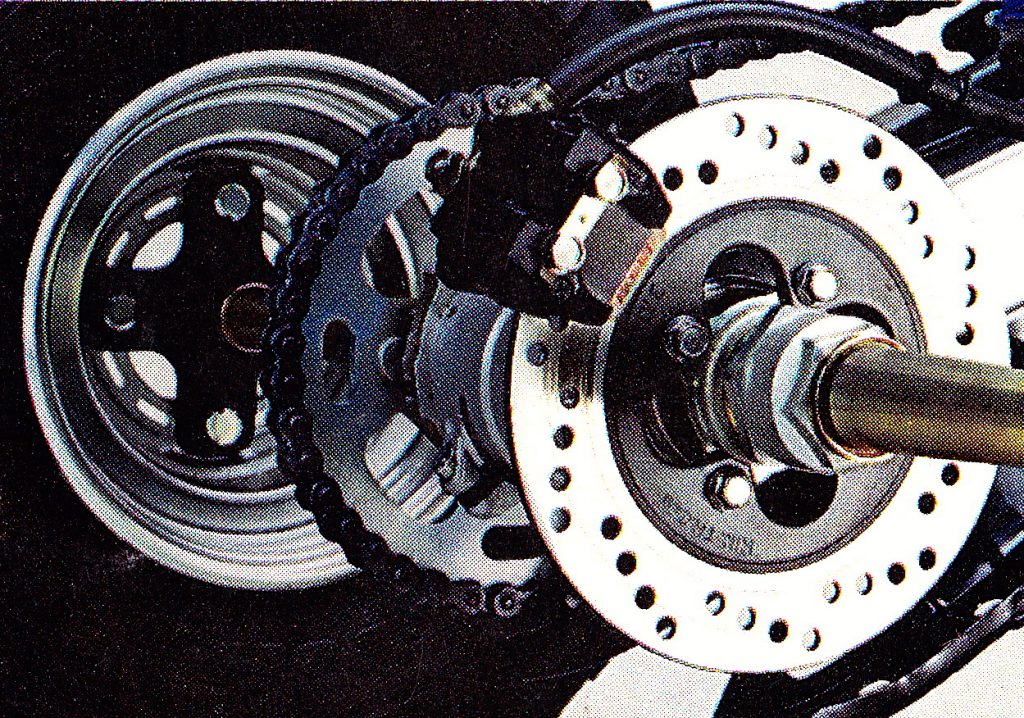 Boat anchor: In addition to its powerful dual front binders, the OW featured a cross-drilled carbon ceramic works Nissin rear disc to slow down the fun.
Boat anchor: In addition to its powerful dual front binders, the OW featured a cross-drilled carbon ceramic works Nissin rear disc to slow down the fun.
Anxious for a change of pace after a rough 1982 season, Glover jumped at the chance to spearhead the new racing program. He would get to ride a full works machine and was reportedly offered a cool $2,000,000 over two years to switch to the Tri-Moto program. Wrenching on the bike would be his longtime mechanic Jim Felt and a full team of Japanese engineers.
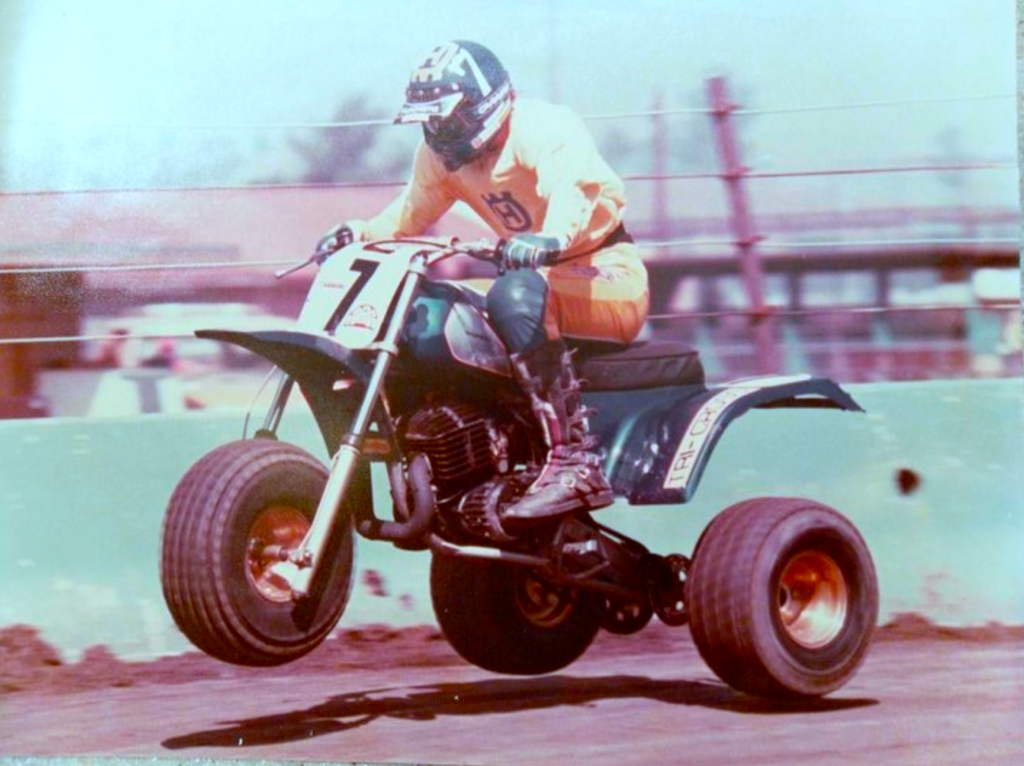 After word got out that Yamaha was fielding a works three-wheeler team to go up against Honda, the other manufacturers were quick to prepare race bikes of their own. Here Husqvarna Factory rider Micky Dymond tests Husky’s top secret works 250 ATC.
After word got out that Yamaha was fielding a works three-wheeler team to go up against Honda, the other manufacturers were quick to prepare race bikes of their own. Here Husqvarna Factory rider Micky Dymond tests Husky’s top secret works 250 ATC.
For the Tri-Moto program, no expense would be spared. Yamaha’s corporate reputation was on the line and, perhaps their financial future. The new machine was to be a clean sheet design and share nothing with any previous Yamaha race bikes. The chassis was cutting edge, using ultra-rigid and lightweight titanium for the main structure and alloy castings for the suspension components. The suspension was full works, with an impressive 5.2 inches of travel front and rear. The rear suspension used an all-new single-shock “Monocross” design, that carried the weight lower and incorporated a true rising rate linkage (something new for Yamaha at the time).

At just shy of 60 horsepower, the POS-83 was closer to a 500 of the day than a traditional 250. While power was prodigious, longevity was not. Each POS motor was good for 30 minutes max, before parts started to grenade.
 In order to get the desired power numbers for the POS-83, Felt and Oliver had to go big on everything. A massive 56mm carb handled the fuel and kept the deep breathing mill happy (the stock YZ250 carb is on the left, the works POS carb is on the right).
In order to get the desired power numbers for the POS-83, Felt and Oliver had to go big on everything. A massive 56mm carb handled the fuel and kept the deep breathing mill happy (the stock YZ250 carb is on the left, the works POS carb is on the right).
 Unobtanium: These hand formed Titanium works pipes each weighed mere ounces and were used to fine tune the POS-83’s massive burst of thrust.
Unobtanium: These hand formed Titanium works pipes each weighed mere ounces and were used to fine tune the POS-83’s massive burst of thrust.
In designing the chassis, Yamaha did not only use exotic materials, they employed unconventional design. Since the arrival of the first ATC, Honda had stuck to a rather “motorcycle-like” weight distribution with their trikes. For the new POS-83 Tri-Moto, Bob Oliver wanted to try something a little different. The POS would use a much more rearward weight bias to allow better tracking through the whoops and make it easier to keep the front wheel off the ground. This played major dividends in the stadium rockers and over doubles where it was critical to avoid landing front tire first.
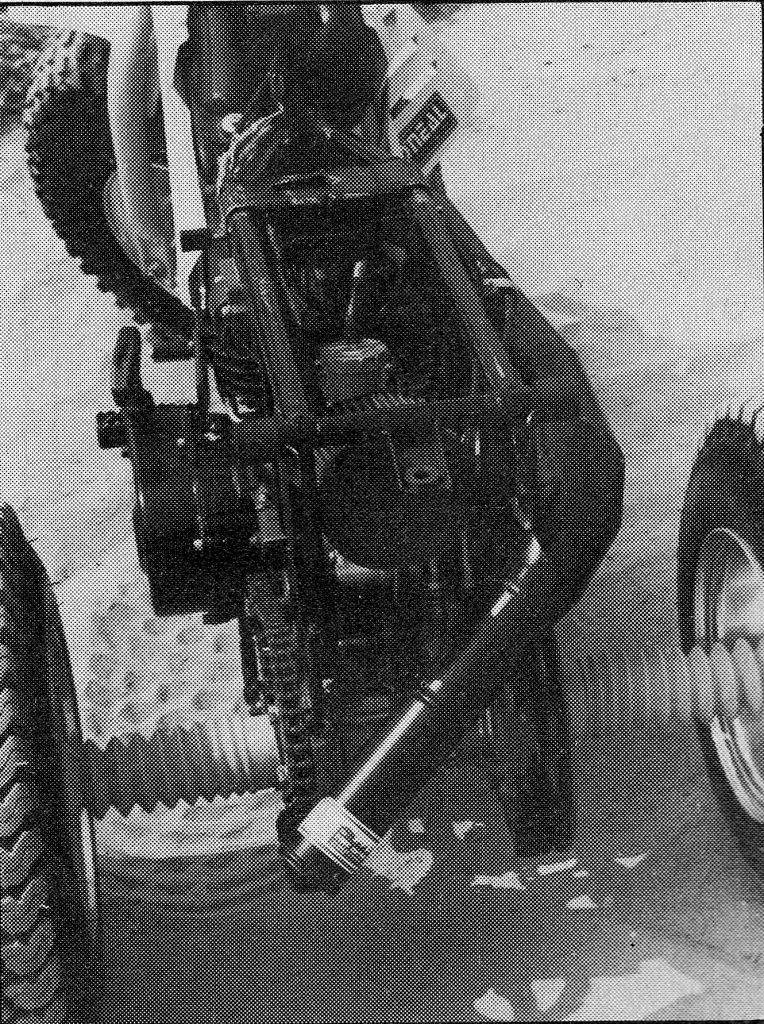 Sano: Cool Factory touched abounded on the POS-83. Items like these super trick works “axle gators” were not available to the average ATV pilot.
Sano: Cool Factory touched abounded on the POS-83. Items like these super trick works “axle gators” were not available to the average ATV pilot.
Powering the bike would be an ultra-trick 249cc two-stroke single that pumped out nearly sixty horsepower to the rear wheels. This works mill used massively hogged out ports, two separate power valve systems, a boost bottle, dual plugs and a set of prototype Boyesen reeds to belt out a screaming banshee of a power spread. The motor was so deep-breathing that Jim Felt had to resort to a 56mm works Mikuni carb to feed enough fuel to prevent the motor from fuel starving on top end. Power was endless and Glover often remarked that the prototype mill felt more like his works 490 than a 250.
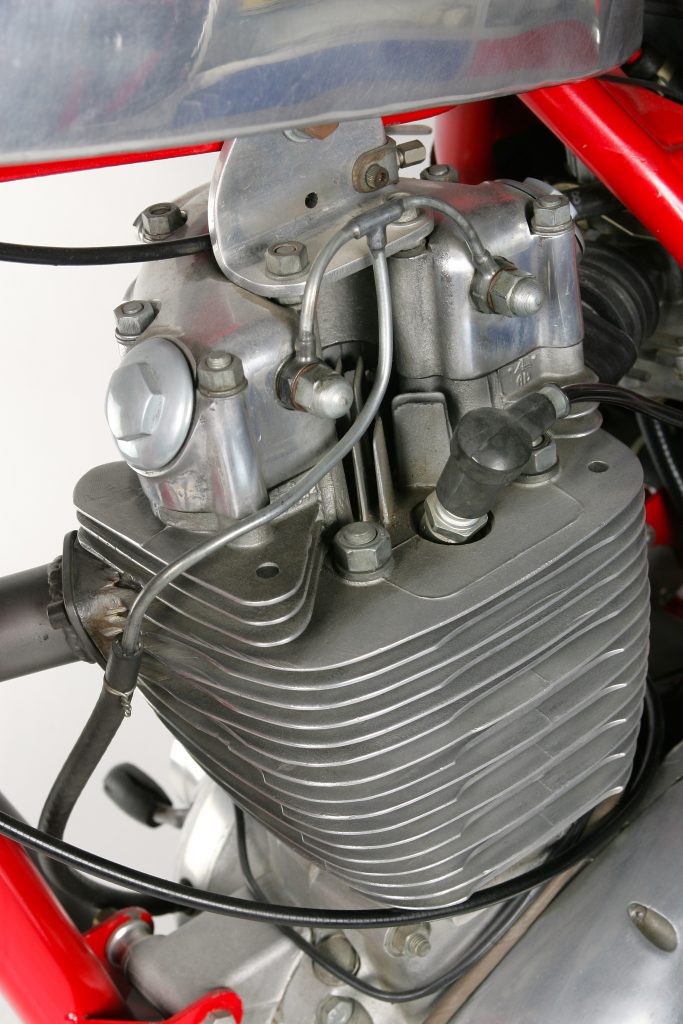 Stripped of all its bodywork, the POS-83’s two-stroke mill is a thing of purposeful beauty.
Stripped of all its bodywork, the POS-83’s two-stroke mill is a thing of purposeful beauty.
All through the ’82 off-season, Glover and Felt burnt the midnight oil trying to work out the bugs of their new machine. This was an all-new bike and there was a lot to get sorted out. On the suspension front, Yamaha was breaking new ground, as this was going to be their first attempt at a cartridge fork and bottom link rear suspension system. Also, there were issues with the innovative dual YPVS valves and their electro-servo governors. Sometimes, the valves would open simultaneously, instead of in stages, and the resulting explosion of power would result in an instant loop out. There were also issues with the titanium frame, which was very light, but extremely brittle. It was necessary to swap out the frames after every 1.5 hours of use to prevent a catastrophic failure. Brakes were also a problem early on, as riders trained on drums, were not accustomed to the incredible stopping force offered by the POS’s dual carbon ceramic discs (The front used a disc on the right and supplemented it with a drum on the left for additional insurance against failure) and super wide works tires.
 Sibling rivalry: Once word got out about the new Tri-Moto project, Yamaha’s other Factory riders were enthusiastic to get involved. Rick Johnson, in particular, loved the new machine and spent a significant portion of the off-season burning laps on the POS-83. By all accounts, the Bad Boy vs. Golden Boy duels at the test track was a sight to behold.
Sibling rivalry: Once word got out about the new Tri-Moto project, Yamaha’s other Factory riders were enthusiastic to get involved. Rick Johnson, in particular, loved the new machine and spent a significant portion of the off-season burning laps on the POS-83. By all accounts, the Bad Boy vs. Golden Boy duels at the test track was a sight to behold.
By spring, the team was ready to make their official debut at the Chicken Licks ATV National and Memorial Mud Bog on April 1st, 1983. By all accounts, Glover was flying on the POS-83 and giving Yamaha’s newest hot shoe, Ricky Johnson fits at the test track on his YZ. The POS gave up a little in weight to the works Yamaha two-wheeler but made up for it with incredible acceleration and traction on the hard-baked SoCal dirt. With Team Honda and Mike Coe debuting an all-new works ATC200SR at Chicken Licks, the pressure would be on for Team Tri-Moto to deliver a victory.
Unfortunately for race enthusiasts everywhere, this titanic clash of ATV juggernauts would never take place. A week before the official race debut of the POS-83 Tri-Moto, Swizcoresan Sinjinmoser would be crushed by a piano, while touring the Yamaha piano plant in Kakegawa, Japan. After the untimely passing of Swizcoresan, the Tri-Moto project would be placed in limbo. In June a new racing head would be named, Mikeatamie Sweenycoka and he would shut down the Tri-Moto program for good. Sweenycoka, an outspoken detractor of three-wheelers, was quick to release a statement declaring: “No Golden boy of mine is going to be caught dead racing a stupid couch!” For his part, Glover would take rest of the year off to pursue his acting interests. In the fall of ’83, Broc would be cast in the pivotal role of Carl, opposite Dom DeLuise and Peter Boyle in the groundbreaking motocross movie, “They call him Carl”.
 In 1983, Bob Hannah just missed out on the Tri-Moto project. His departure to Team Honda prevented him from assisting in the development of the POS-83. Even so, he would make an ATV racing attempt of his own three years later. After his stint at Factory Honda ran its course, Buckwheat would make the jump to Suzuki to head their new Quadracer program in 1986.
In 1983, Bob Hannah just missed out on the Tri-Moto project. His departure to Team Honda prevented him from assisting in the development of the POS-83. Even so, he would make an ATV racing attempt of his own three years later. After his stint at Factory Honda ran its course, Buckwheat would make the jump to Suzuki to head their new Quadracer program in 1986.
After the unfortunate piano incident, Yamaha would pull out of the ATV business entirely and rededicate the company to making the best damn pianos money can buy. Broc Glover would go back to racing dirt bikes, capturing the 1983 500 National Motocross championship. Today, he is a rep for Dunlop, and still known as “Carl” to countless thousands of adoring fans.
 After the failure of the Tri-Moto project, Yamaha would not field another ATV motocross team for 15 years. In 1998, Yamaha would lure Jeremy McGrath away from Factory Suzuki to spearhead their new Factory ATV racing team. The King of Supercross would reward them with a record seven straight National ATV MX titles on his Skip Norfolk tuned Banshee.
After the failure of the Tri-Moto project, Yamaha would not field another ATV motocross team for 15 years. In 1998, Yamaha would lure Jeremy McGrath away from Factory Suzuki to spearhead their new Factory ATV racing team. The King of Supercross would reward them with a record seven straight National ATV MX titles on his Skip Norfolk tuned Banshee.
Happy April Fool’s Day!
For your daily dose of old-school moto goodness, make sure to follow me on Twitter-@TonyBlazier




